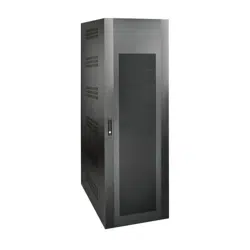Loading ...
Loading ...
Loading ...

5
3. Battery Cabinet Installation
3.2 Transportation
1. Inspect the shipping container(s) for visible damage (do not remove the stretch wrap around the unit until it has been transported to
the final installation location). Confirm that the model name and rating match the unit you ordered. If you determine the unit has been
damaged during shipping or if anything appears to be missing, contact Tripp Lite for assistance. Do not attempt to use the unit if it has
been damaged or mishandled.
2. Do not attempt to move or unpack the battery cabinet without assistance. Use appropriate handling equipment rated to bear the weight
and bulk of the battery cabinet, such as freight elevators, pallet jacks and forklifts. (Fully extend forks under load. Spread forks to
maximum possible width under load. Lift cabinet from bottom only. Wear safety shoes.) Confirm load limits for freight elevators, handling
equipment and floors along the transport route are not exceed by the combined weight of the packaged battery cabinet, handling
equipment and personnel. Confirm that the packaged unit will pass through any doorways along the intended route.
3. The battery cabinet is secured with stretch wrap to protect it during shipping and movement within a facility. Remove the stretch wrap
from the battery cabinet when the unit is in the final installation location—not before.
3.3 Mechanical Check
While the assembled cabinet battery system is still on the shipping pallet, inspect all sides for impact or other damage.
1. Open the front door of the battery cabinet.
2. Confirm none of the individual batteries included on a separate pallet are damaged (applies to BP480V370 model only).
3. Confirm that none of the internal parts (terminal blocks, circuit breakers and other parts) have been damaged.
4. Note the individual battery model number. Refer to Section 6.2 for the battery’s terminal type and recommended torque.
5. Use insulated tools to tighten all battery terminal connections to the recommended torque.
6. Use insulated tools to tighten the cables from the positive and negative output terminals at the end batteries to the circuit breaker.
3.4 Internal Wiring (Typical)
• Battery cabinets use multiple 12V DC batteries connected in series to provide nominal DC voltage of 480V DC (±240V DC).
• Internal cabling is sized for specific application load currents. Do not use any other cable size other than the one provided in the battery
cabinet.
• Each battery cabinet shelf includes a specific wiring diagram.
• All circuit breakers are in the middle tier of the battery cabinet.
• All load connection polarities will be marked by a POS (+) or NEG (-) label (or an “N” center label for ±240V DC strings).
• All battery cabinets are provided with a branch circuit overcurrent protection device and may be wired directly to the load or UPS.
3.5 Preliminary Electrical Check (After Battery Installation)
1. Reset the circuit breaker to the “On” position and measure the battery cabinet output voltage at the output load connection points.
Measure voltage with a digital voltmeter.
2. The measured voltage should approximately match the voltage listed on the battery cabinet nameplate. The battery cabinet output
voltage will be equal to the number of individual batteries installed in series multiplied by the unit voltage. For example: 40 batteries x
12.84V DC = 513.6V DC output.
3. If the measured voltage is significantly different than anticipated, determine the cause (e.g. low charge, shorted cell, reversed battery,
faulty wiring) and correct the voltage disparity before proceeding.
4. Set the circuit breaker to the “off” position as a safety precaution during installation.
3.6 Battery Cabinet Placement
Place the battery cabinet in a cool location with free airflow and away from direct heat sources. The lifespan and performance of a battery
may be dramatically affected by elevated temperature, decreasing 50% for each 8.25° C above 25° C.
1. Prepare the surface where the cabinet will be placed. The surface must be clean, flat and able to support the battery cabinet and other
equipment installed nearby. See Section 7.4 for floor loading specifications.
2. Allow adequate clearance around the front and rear of the battery cabinet for ventilation and maintenance. The front door must be
accessible to allow easy access to internal batteries, internal fuses and other overcurrent protection devices. See Section 6.1 for
dimensions and battery cabinet measurements.
3. If the cabinet will be anchored to the floor, install appropriate anchor bolts in the mounting hole located at the bottom of the cabinet. Use
washers to create a level surface between the mounting areas around the anchor bolts.
4. Using extreme caution, remove the bolts securing the battery cabinet to the shipping pallet.
Loading ...
Loading ...
Loading ...
